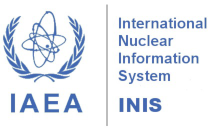Computational Fluid Dynamics study of element type and turbulence model impact on a flow over a spacer grid using Simcenter STAR-CCM+
DOI:
https://doi.org/10.15392/2319-0612.2024.2658Keywords:
CFD, Spacer grids, Mesh analysisAbstract
Abstract: This study presents a numerical investigation into the impact of various mesh element types on water flow results through a representative spacer grid, utilizing Computational Fluid Dynamics (CFD). The study evaluates the variations of the k−ϵ turbulence model available in Simcenter STAR-CCM+ across different mesh types. Three predominant cell types were employed: cartesian, polyhedral, and tetrahedral, alongside three k−ϵ models: Standard Two-layer (STL), Realizable Two-layer (RTL), and Elliptic Blending (EB). The analysis was conducted using a PWR vane-type spacer grid arranged in a 2x2 configuration. The findings demonstrated a strong correlation with experimental data available in the literature. However, the cartesian and tetrahedral meshes attenuated the velocity profiles post-spacer grid. The polyhedral mesh, in conjunction with the RTL and EB k−ϵ models, yielded results more closely aligned with the experimental data. Regarding Secondary Flow (SF), the results indicated a consistent trend of decreasing intensity downstream of the spacer grid. The Polyhedral EB and RTL models exhibited behavior most consistent with the experimental results.
Downloads
References
[1] Siemens Digital Industries Software. Simcenter STAR-CCM+ User Manual. Disponível em: https://plm.sw.siemens.com/en-US/simcenter/fluids-thermal-simulation/star-ccm/. Acesso em: 2024.
[2] SANTOS, A. A. C. Investigação numérica e experimental do escoamento de água em feixe de varetas representativo de elementos combustíveis nucleares de reatores do tipo PWR. PhD Dissertation. Universidade Federal de Minas Gerais, Belo Horizonte, 2012.
[3] NAVARRO, M. A.; SANTOS, A. A. Evaluation of a numeric procedure for flow simulation of a 5x5 PWR rod bundle with a mixing vane spacer. Progress in Nuclear Energy, v. 53, p. 1190-1196, 2011. DOI: https://doi.org/10.1016/j.pnucene.2011.08.002
[4] IKEDA, K. CFD application to advanced design for high efficiency spacer grid. Nuclear Engineering and Design, v. 279, p. 73-82, 2014. DOI: https://doi.org/10.1016/j.nucengdes.2014.02.013
[5] PODILA, K.; RAO, Y.; KRAUSE, M.; BAILEY, J. A CFD simulation of 5x5 rod bundles with split-type spacers. Progress in Nuclear Energy, v. 70, p. 167-175, 2014. DOI: https://doi.org/10.1016/j.pnucene.2013.08.012
[6] CHEN, X.; DU, S.; ZHANG, Y.; YU, H.; LI, S.; PENG, H.; WANG, W.; ZENG, W. Validation of CFD analysis for rod bundle flow test with vaned spacer grids. Annals of Nuclear Energy, v. 109, p. 370-379, 2017. DOI: https://doi.org/10.1016/j.anucene.2017.05.055
[7] WANG, M.; JU, H.; WU, J.; QIU, H.; LIU, K.; TIAN, W.; SU, G. A review of CFD studies on thermal hydraulic analysis of coolant flow through fuel rod bundles in nuclear reactor. Progress in Nuclear Energy, v. 171, 2024. DOI: https://doi.org/10.1016/j.pnucene.2024.105175
[8] NAVARRO, M. A.; SANTOS, A. A. Numerical evaluation of flow through a 5x5 PWR rod bundle: effect of the vane arrangement in a spacer grid. In: PROCEEDINGS OF THE INTERNATIONAL NUCLEAR ATLANTIC CONFERENCE (INAC), 2009, Rio de Janeiro, Rio de Janeiro, Brazil. Numerical evaluation of flow through a 5x5 PWR rod bundle: effect of the vane arrangement in a spacer grid. Rio de Janeiro, Rio de Janeiro, Brazil: INAC, 2009.
[9] SANTOS, A. A.; BARROS FILHO, J. A.; NAVARRO, M. A. Verification and validation of a numeric procedure for flow simulation of a 2x2 PWR rod bundle. In: PROCEEDINGS OF THE INTERNATIONAL NUCLEAR ATLANTIC CONFERENCE (INAC), 2011, Belo Horizonte, Minas Gerais, Brazil. Verification and validation of a numeric procedure for flow simulation of a 2x2 PWR rod bundle. Belo Horizonte, Minas Gerais, Brazil: INAC, 2011.
[10] WANG, W.; CAO, Y.; OKAZE, T. Comparison of hexahedral, tetrahedral and polyhedral cells for reproducing the wind field around an isolated building by LES. Building and Environment, v. 195, 2021. DOI: https://doi.org/10.1016/j.buildenv.2021.107717
[11] HEFNY, M. M.; OOKA, R. CFD analysis of pollutant dispersion around buildings: Effect of cell geometry. Building and Environment, v. 44, p. 1699-1706, 2009. DOI: https://doi.org/10.1016/j.buildenv.2008.11.010
[12] CINOSI, N.; WALKER, S.; BLUCK, M.; ISSA, R. CFD Simulation of turbulent flow in a rod bundle with spacer grids (matis-h) using STAR-CCM+. Nuclear Engineering and Design, v. 279, p. 37-49, 2014. DOI: https://doi.org/10.1016/j.nucengdes.2014.06.019
[13] XIONG, J.; LU, C.; QU, W. Validation for CFD simulation in rod bundles with split-vane spacer grids based on LDA measurement. Frontiers in Energy Research, v. 8, p. 43, 2020. DOI: https://doi.org/10.3389/fenrg.2020.00043
[14] JONES, W. P.; LAUNDER, B. E. The prediction of laminarization with a two-equation model of turbulence. International journal of heat and mass transfer, v. 15, p. 301-314, 1972. DOI: https://doi.org/10.1016/0017-9310(72)90076-2
[15] RODI, W. Experience with two-layer models combining the k-epsilon model with a one-equation model near the wall. In: 29th Aerospace sciences meeting, January 1991, Reno, NV, USA. INAC. Reno, NV, USA: AIAA, 1991. DOI: https://doi.org/10.2514/6.1991-216
[16] SHIH, T.-H.; LIOU, W. W.; SHABBIR, A.; YANG, Z.; ZHU, J. A new k-eddy viscosity model for high Reynolds number turbulent flows. Computer & fluids, v. 24, p. 227-238, 1995. DOI: https://doi.org/10.1016/0045-7930(94)00032-T
[17] DURBIN, P. A reynolds stress model for near-wall turbulence. Journal of Fluid Mechanics, v. 249, p. 465-498, 1993. DOI: https://doi.org/10.1017/S0022112093001259
[18] MANCEAU, R.; HANJALI’C, K. Elliptic blending model: A new near-wall reynolds-stress turbulence closure. Physics of Fluids, v. 14, p. 744-754, 2002. DOI: https://doi.org/10.1063/1.1432693
[19] BILLARD, F.; LAURENCE, D. A robust k- ε- v2/k elliptic blending turbulence model applied to near-wall, separated and buoyant flows. International Journal of Heat and Fluid Flow, v. 33, p. 45-58, 2012. DOI: https://doi.org/10.1016/j.ijheatfluidflow.2011.11.003
[20] CHEN, QINGYAN. "Comparison of different k-ε models for indoor air flow computations." Numerical Heat Transfer, Part B Fundamentals, v. 28, p. 353-369, 1995. DOI: https://doi.org/10.1080/10407799508928838
[21] XIONG, M., CHEN, B., ZHANG, H. and QIAN, Y. Study on accuracy of cfd simulations of wind environment around high-rise buildings: a comparative study of k-ε turbulence models based on polyhedral meshes and wind tunnel experiments, Applied Sciences, v. 12, p. 7105, 2022. DOI: https://doi.org/10.3390/app12147105
[22] KAROUTAS, Z.; GU, C.-Y.; SCHÖLIN, B. 3-D flow analyses for design of nuclear fuel spacer. In: PROCEEDINGS OF THE US NUCLEAR REGULATORY COMMISSION (NRC), 10-15 September 1995, Saratoga Springs, NY, USA. 3-D flow analyses for design of nuclear fuel spacer. Saratoga Springs, NY, USA: US Nuclear Regulatory Commission, 1995.
[23] CHUN, T.-H.; OH, D.-S. A pressure drop model for spacer grids with and without flow mixing vanes. Journal of Nuclear Science and Technology, v. 35, p. 508-510, 1998. DOI: https://doi.org/10.1080/18811248.1998.9733899
[24] IN, W. K.; OH, D. S.; CHUN, T. H. Empirical and computational pressure drop correlations for pressurized water reactor fuel spacer grids. Nuclear techonology, v. 139, p. 72-79, 2002. DOI: https://doi.org/10.13182/NT02-A3305
Downloads
Published
Issue
Section
Categories
License
Copyright (c) 2025 Tiago Augusto Santiago Vieira, Yasmim Martins Carvalho, Higor Fabiano Pereira de Castro, Keferson Almeida Carvalho, Rebeca Cabral Gonçalves, Pedro Henrique Araújo, Davi Cury, Vitor Vasconcelos Araújo Silva, Graiciany Paula Barros, Andre Augusto Campagnole dos Santos

This work is licensed under a Creative Commons Attribution 4.0 International License.
Licensing: The BJRS articles are licensed under a Creative Commons Attribution 4.0 International License, which permits use, sharing, adaptation, distribution and reproduction in any medium or format, as long as you give appropriate credit to the original author(s) and the source, provide a link to the Creative Commons license, and indicate if changes were made. The images or other third party material in this article are included in the article’s Creative Commons license, unless indicated otherwise in a credit line to the material. If material is not included in the article’s Creative Commons license and your intended use is not permitted by statutory regulation or exceeds the permitted use, you will need to obtain permission directly from the copyright holder. To view a copy of this license, visit http://creativecommons.org/licenses/by/4.0/






















